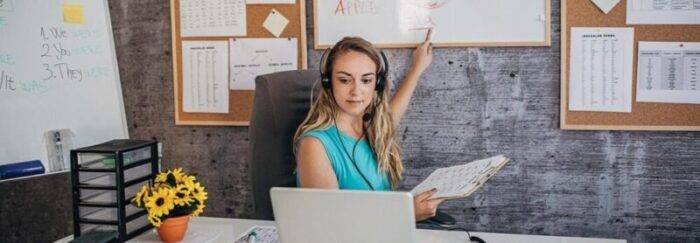Last Updated on July 4, 2024 by Team Experts
With all that is going on in the education industry in response to COVID-19, both students and teachers are finding new ways to connect with each other. Thanks to technology, all things that were happening in a normal classroom are still happening, and it’s all online. Normal classroom setup has been replaced by virtual classrooms. Virtual classrooms are online learning environments where students and teachers engage with each other. The key distinction of a virtual classroom is that it happens in a live and synchronous setting.
Benefits of a virtual classroom
Allows students in different locations to interact with each other to engage in learning activities. Virtual training offers a synchronous experience meaning it happens in real-time. Among all benefits, it allows students to pursue their education along with career and tutors to earn an extra income.
Now let’s explore the benefits.
Flexible schedule
Virtual classrooms are great for both tutors and students who want to advance their education alongside their busy life. Online learning allows for a far more flexible schedule where both tutors and students can decide the time that is comfortable for them. The virtual classroom offers more control over the schedule.
Better cost-efficiency
The best thing about running a virtual classroom is the online part. It helps you to cut off a lot of costs including commuting costs and paying for utilities. As most online classes promote digital learning materials, there is no need for physical books as well. This again cuts down a lot of money. When there is no overhead, it helps teachers to just invest in building a full-fledged virtual classroom to make your virtual classes incredible. And students are just paying for your experience and expertise alone.
Course varieties
When compared with traditional learning, virtual learning presents opportunities to learn different types of courses. For example, you might find tutors who specialize in niche subjects that otherwise aren’t taught commonly in universities.
Networking opportunities
Allows not only tutors but students to connect with students from all around the world, offering networking opportunities you can’t get through a traditional classroom setup.
Important elements of a virtual classroom setup
Typically, educators create their own virtual classroom which meets their individual standards and requirements. However, there are some of the important elements that need to be considered to improve the teaching experience considerably.
Simulate a quality learning environment
When creating a virtual classroom, simulate a quality learning environment similar to a physical learning environment. Use the best quality live streaming and presentation tools and easy-to-use collaboration features to create the best experience.
Interactive Features
Integrate features like whiteboards chat rooms, emojis, polls, etc. for interactive teaching to create an interactive learning environment and engage students.
Features for easy and quick sharing
Sharing learning materials with students is one of the most important and frequent activities. Implement features for sharing audio, video, screens, and other learning materials to create a positive learning experience in your virtual classroom.
Develop a guide for tutors
If you are planning to allow other tutors to use your virtual classroom, you must develop a guide that tutors can use. Make a step by step manual explaining how to conduct each virtual class, what they need to follow, classroom and preparation, the outline of curriculum and training activities, and goals of each live training session.
Setting up a virtual classroom
The global virtual classroom market is predicted to reach $19.6 billion by 2024. With widespread adoption and participation in learning, the demand for virtual classrooms is increasing. If you can offer a live and engaging classroom experience online that is as good as or maybe better than a traditional classroom setup, why wouldn’t you? If you are looking for how to set up a virtual classroom, let’s see how to implement it.
List out your goals
To start with, list your requirements, objectives, and goals for setup. Determining your goals will help you to choose the right tools and materials that will serve your goals well. Before determining your needs and goals, consider the following things.
- The interests and preferences of your target audience
- Have an understanding of the desired outcome.
Preferably, conduct a market analysis by keeping your target audience in mind to design a customized learning space for your students.
Choose the content delivery method
The important step of building a virtual classroom is to choose how to deliver your classes to your students. To make the right decisions, consider how you want your students to access your virtual classroom. Do you want them to access your virtual classroom from the laptop or their smartphones? Another thing to consider is the type of content you would be using in your live classes. The attention span of learners these days is shorter than ever. Hence it is important to enrich your online classes by using charts, diagrams, infographics, videos, etc. along with writing on the whiteboard to make your virtual classes interesting. Having an idea about these factors will help you to choose the right multimedia tools that support the content delivery method you choose.
Build your virtual classroom
To connect with your students, you must use the right medium that facilitates a great learning environment. While there are a lot of video conferencing tools like Zoom, or Skype to help you get in touch with your students, those options are scalable enough as your virtual learning business grows. The best recommendation is to build your customized virtual classroom using online tutoring software that supports your content delivery.
To conclude
Training has become mainstream due to the ease and flexibility of learning and cost-efficiency. To leverage the potential of the industry, you can build a virtual classroom to connect with a global student base. By following the right techniques and strategies in delivering your classes, you can effectively offer the best live learning experience to your students.
Also read about: Zoom Clone app: An all-in-one anchor for every industry

